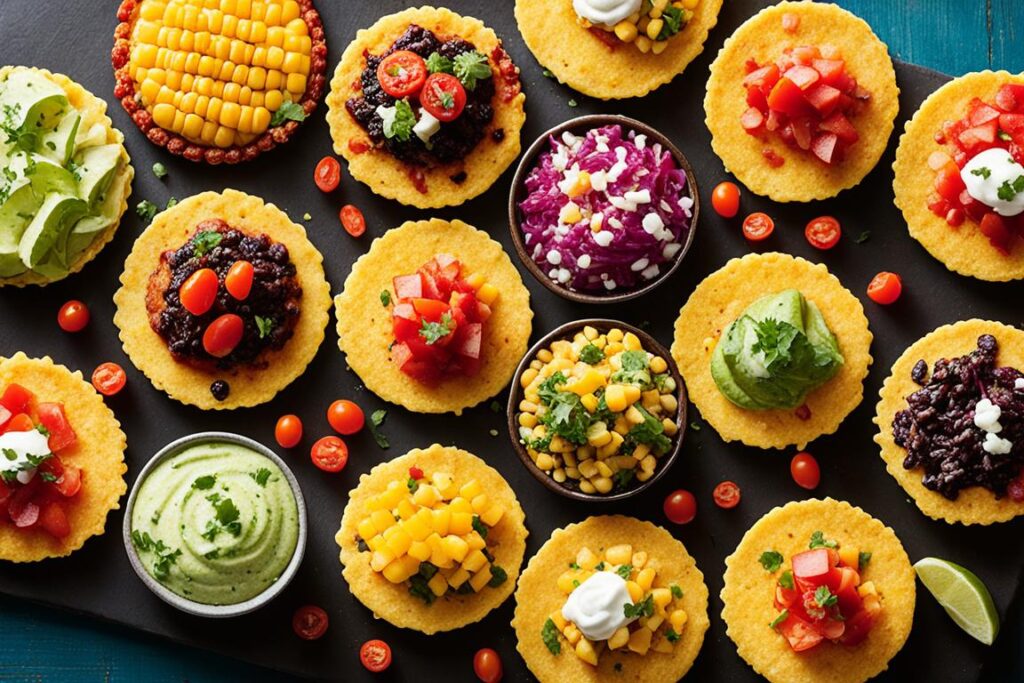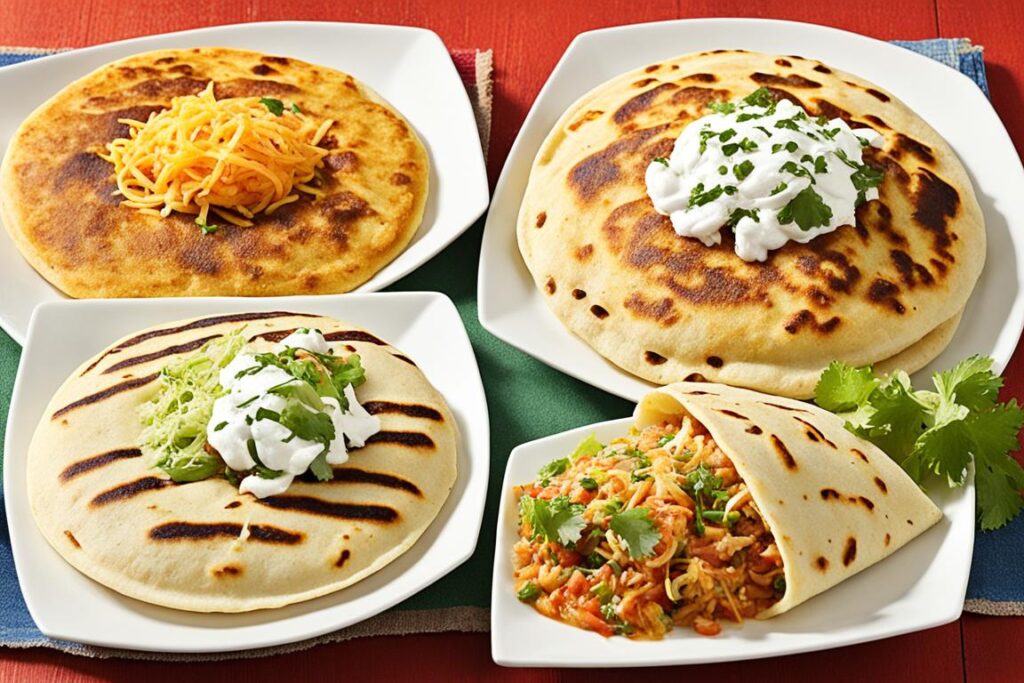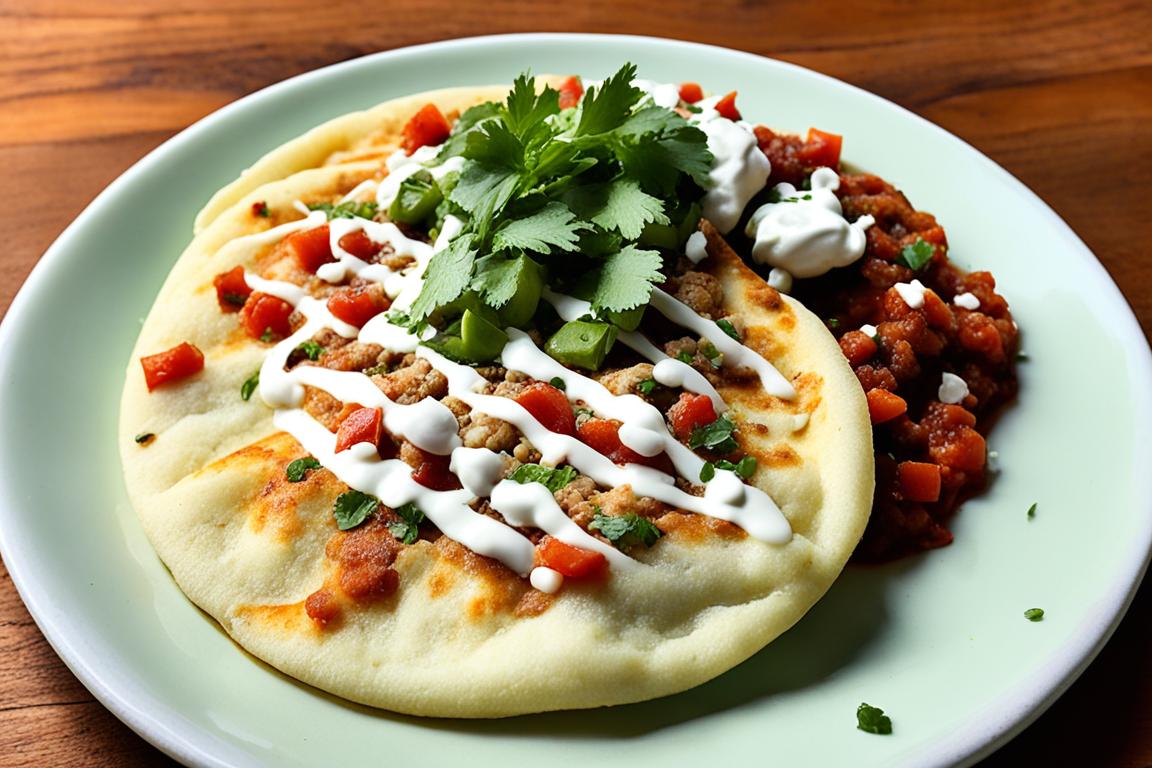Ever wondered about the Mexican version of a pupusa? Pupusas are famous for their thick corn cakes stuffed with various fillings. But in Mexico, there’s a twist. Let’s dive into what makes the Mexican version special.
The Mexican version is called a gordita. It’s a corn-based dish that’s just as tasty as its Salvadoran cousin. But what makes it unique?
Gorditas are smaller and softer than pupusas. They’re made with a special type of masa that makes them extra tender. You can fill them with meat, cheese, or veggies for a delicious meal.
So, while pupusas are a staple in El Salvador, gorditas are a beloved dish in Mexico. Both are corn-based and filled with tasty ingredients. But they have their own special touches that set them apart.
Key Takeaways
- Pupusas and gorditas are both corn-based dishes celebrated in their respective countries.
- Gorditas offer different preparation styles and ingredient variations than pupusas.
- The cultural significance of gorditas reflects the rich culinary diversity of Mexico.
- Understanding these dishes helps appreciate the nuances of Latin American cuisine.
- Exploring the differences enhances the culinary experience for food lovers.
Introduction to Pupusas
Pupusas are a big part of Salvadoran food and are known as the national dish of El Salvador. They are made with a thick corn tortilla from masa harina. This is the main ingredient in a pupusa.
The tortillas are filled with things like cheese, refried beans, and meats like pork or chicken. This makes them a filling meal.
When cooked on a griddle, pupusas turn golden brown. They have a special texture and taste. Curtido, a tangy fermented cabbage slaw, and a tasty salsa are often served with them. Together, they make the pupusa dish very tasty and loved by many.
Now, pupusas are popular not just in Central America but also in the United States. People there love to try these authentic Salvadoran flavors. This shows how much pupusas mean to people and how diverse American food has become.
Origin of Pupusas
The debate over who created pupusas is between El Salvador and Honduras. Both claim they are the birthplace of these thick griddle cakes. They are a big part of Salvadoran cuisine and are very important to the area.
Archaeologists say the Pipil tribes, who lived in what is now El Salvador, made pupusas. These tribes used masa harina, a special cornmeal dough. This dough is made through a process called nixtamalization, which makes the corn taste better and easier to digest.
Pupusas have been a key part of Salvadoran food for a long time. They are celebrated on National Pupusas Day, showing how important they are to Salvadorans. The history of pupusas tells us about the dish’s growth and its role in Salvadoran culture and pride.
| Element | Details |
|---|---|
| Country of Origin | El Salvador |
| Main Ingredients | Masa harina (cornmeal), various fillings |
| Cultural Significance | Staple of Salvadoran cuisine, celebrated annually |
| Archaeological Evidence | Linked to Pipil tribes |
| Cooking Method | Griddled on a comal |
What is the Mexican version of a pupusa?
The gordita is the Mexican version of a pupusa, with a delightful twist on traditional flavors. It means “little fatty” in Spanish. Gorditas are thicker and rounder corn cakes made from masa harina, just like pupusas.
The Gordita: A Similar Delight
Gorditas are often served split open for an open-faced meal. This style makes every bite a joy. They have an air pocket that lets you fill them with cheese, meats, and chiles, offering a variety of flavors.
Comparing Altered Ingredients in Gorditas
Gorditas and pupusas both use masa harina, but their fillings are different. Pupusas have fillings like refried beans and shredded pork. Gorditas use regional ingredients, offering a taste of Mexican diversity. This makes trying different fillings exciting for food enthusiasts.
| Aspect | Pupusa | Gordita |
|---|---|---|
| Thickness | Thinner | Thicker |
| Filling Method | Enclosed | Open-faced |
| Common Fillings | Beans, cheese, pork | Cheese, meats, chiles |
| Cooking Style | Grilled or fried | Grilled or fried |
The gordita is a charming alternative to the pupusa in Mexican cuisine. It offers a rich variety in flavors and textures. For a guide on making traditional pupusas, visit this helpful guide.
Distinct Characteristics of Mexican Corn Cakes
Mexican corn cakes, like gorditas, have special traits that show their rich taste and cultural value. These traits make characteristics of Mexican corn cakes unique. They also show how different regions add their own flavors and techniques to these dishes.
Variations of Gorditas
Gorditas come in many types, each telling a story of local traditions and ingredients. They are often made with:
- Chicharrón prensado (pressed pork cracklings)
- Cheese
- Potato
These ingredients make each gordita special. They show the region’s culture and tastes. The mix of flavors gives a peek into local food habits.
How Gorditas Are Served Compared to Pupusas
Serving gorditas is different from serving pupusas. While pupusas go with curtido, a pickled cabbage slaw, gorditas are served with:
- Salsas
- Fresh vegetables
- Guacamole
This shows how gorditas have their own unique taste. Gorditas can also be filled with hot ingredients. This adds a fun twist to eating them.

For more info on these tasty dishes, check out Amalia Recipes. It’s full of cooking tips, family recipes, and how to make meals that bring people together.
Exploring Other Comparable Mexican Dishes
Mexican cuisine is full of tasty dishes similar to pupusas. Sope, huarache, and tlacoya are great examples. They all use masa, which is important in Mexican cooking. Each dish brings its own unique flavors to the table.
Sope: Thick Corn Cakes with a Border
Sope has a thick tortilla with raised edges. These edges hold toppings like beans, meats, cheese, and salsas. It’s a great choice for a filling meal that tastes like traditional Mexican food.
Huarache: The Elongated Corn Treat
Huarache looks like a sandal because it’s long and flat. It’s topped with meats, veggies, and sauces or crema. The mix of masa and toppings makes it a favorite in Mexican cuisine.
Tlacoya: The Flatbread with a Twist
Tlacoya is a flat corn cake filled with beans. You can add toppings or serve it with different condiments. It shows the simple, rustic side of Mexican food and its many filling options. Sope, huarache, and tlacoya all celebrate Mexico’s rich food traditions.
For those interested in Latin American cuisine, this source is a great resource. It explores the flavors and varieties of dishes like pupusas, perfect for food lovers.
Gorditas vs. Pupusas: Key Differences
The world of food is full of tasty corn-based dishes. Gorditas and pupusas are two that really stand out. They offer different experiences for those who love food. Let’s look at the differences between gorditas and pupusas. We’ll see how they differ in structure, preparation, and how they are served.
Gorditas are made from masa harina and can be fried or cooked on a griddle. They puff up when cooked. After cooking, they are cut open and filled with many different ingredients. This makes them very customizable.
Pupusas are bigger and flatter than gorditas. They are filled with masa harina before cooking. This makes them smooth on the inside when they’re done.
Pupusas come with a tangy pickled slaw called curtido. Gorditas, on the other hand, are topped with various salsas and toppings. This shows how each dish has its own unique way of being enjoyed.

Filling Options for Mexican Corn Cakes
Exploring the fillings for Mexican corn cakes shows a wide range of flavors. These fillings make gorditas and pupusas a hit with food lovers. They offer many tastes to choose from.
Popular Fillings for Gorditas
Gorditas are loved for their filling flavors. Here are some top fillings:
- Cheese – A classic choice that melts beautifully, adding richness.
- Beans – A staple option that provides a nutritious component.
- Meats – Varieties like pork, chicken, or beef bring a savory flavor.
- Vegetables – Ingredients such as peppers, onions, and zucchini can offer freshness and crunch.
Gorditas offer a tasty experience with their fillings.
Comparison to Pupusa Fillings
Pupusas have fewer fillings but they’re just as tasty. Common fillings include:
- Crispy chicharrón – Adds a savory depth and texture.
- Creamy cheese – Achieves a delightful melty consistency.
- Beans – Like gorditas fillings, this option ensures a wholesome element.
This shows how different regions have their own food traditions. The diversity in fillings makes each dish special. These choices make every bite unique, pleasing many food lovers.
Cultural Significance of Gorditas in Mexico
Gorditas are more than just tasty corn cakes in Mexico. They are a key part of Mexican food culture. You can find them at street markets and local spots, connecting families and communities. They symbolize the rich flavors and cooking skills passed down through generations.
In Mexican homes, making gorditas is a big deal during family get-togethers and holidays. They can be filled with many things, pleasing everyone’s taste. Plus, they’re a popular snack everywhere, bringing people together over good food.
Preparing and eating gorditas shows Mexico’s rich heritage. They highlight local ingredients and cooking methods. Gorditas keep the tradition of home-cooked meals alive, bringing happiness to those who enjoy them.


